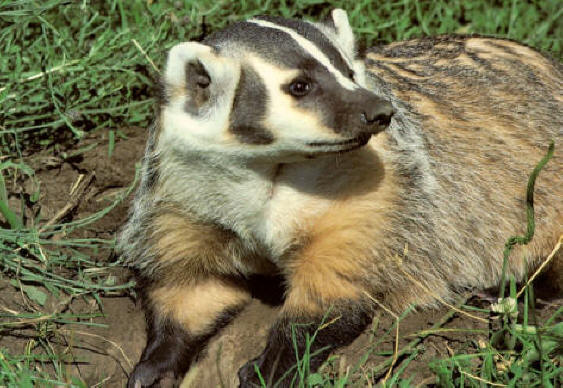On March 20, while exploring the reserve east of the old barn, several of us were startled to see a new face on the landscape.
There was no doubt about the animal we were viewing - it was an American badger. The distinctive black-and-white-striped face stared intently at us as we looked at it through our binoculars at a distance of about 100 meters.
The badger was crouched atop a dirt mound that was riddled with California ground squirrel burrows. The facial stripes are dramatic, making the badger an unmistakable sight. The low-slung body was covered with grizzled gray-brown fur. We could see the short, stout legs. Badgers have incredibly long and strong front claws that they use for digging. The badger is a supreme digger. And this they do in order to capture one of their favorite prey – the ground squirrel.
As we watched, the badger slowly lowered its body to the ground until it was nearly impossible to see. It seemed to melt into the reddish soil, with only its forehead and small black eyes visible.
Then, as we took a few steps forward, the badger zipped out of sight into one of many holes riddling the mound. That was the last we would see of it that day.
The badger is called a fossorial carnivore because of its habit of living underground. It raises its young underground, and this is the subterranean world where it pursues its prey: gophers, ground squirrels, ground hogs, marmots, pikas, prairie dogs, deer mice and voles. They will also eat burrowing owls.
According to some studies, they will sometimes form mutually beneficial relationships with coyotes. Coyotes are common on the campus grasslands, but they are not good diggers. Coyotes will, of course, chase prey once they are above ground. Badgers, on the other hand, are not fast runners, but are well adapted to digging. Even through their altogether different modes of finding food, these two top carnivores are very effective at keeping small rodent populations in check.
Badgers are found all across western North America, but they also occur as far east as Pennsylvania. Their preferred habitat is grasslands, agricultural fields, and other treeless areas that have soils that are not too difficult to dig.
This makes the campus reserve grasslands a perfect habitat for them.
In April, badgers were even sighted from the Le Grand parking lot, just beyond the irrigation canal to the east. Though normally nocturnal, our sighting in March was at mid-day.
So keep an eye out across the grasslands to the east and you, too, might get lucky and spy a badger.



